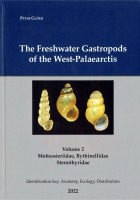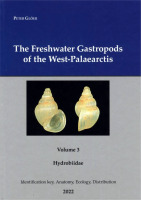Back in the days when I was still a rookie in malacology and my interest was turning towards the southeastern European fauna, I would have welcomed a synthesis work that would have shown the whole European fauna (including southern Europe and western Asia) in one and I know I was not alone.
László Pintér, my former mentor, cooled me down by saying that southern and south-eastern Europe and the southern part of Western Asia (Anatolia) are too species-rich to have an expert who can oversee all the groups and would undertake a comprehensive faunal summary of such a diverse area.
I was getting used to the fact that there is and will never be such a comprehensive work and if I need something I am forced to look for it in monographs or check-lists of individual countries (if any), in small group revisions (if any) or in all kinds of short faunistic and short taxonomic papers.
A real milestone was Francisco Welter-Schultes’ Guide for Species Identification of the European non-marine Molluscs, published in 2012, the popularity of which showed how much such a summary was missing before.
But even Welter-Schultes did not attempt to deal with the spring-snails (Rissooidea and Hydrobioidea freshwater snail groups). As he wrote “… hundreds of species are recognized and classified in more than 100 genera. Almost every time a species is mentioned in the literature it has another genus. This has made it extremely sophisticated to learn more about these animals and aggregate information on species from various sources…”.
Spring-snails undoubtedly form the most abundant group of snails, with most species having a very small range, so-called micro-endemisms. Even if they occur at the surface, they are mostly found in springs, but the majority are subterranean, where they either true stygobionts or they populate the interstitial waters of shallow subterranean habitats (so-called MSS). It is no wonder that the world of subterranean waters is called ‘the last frontier in freshwater biodiversity research’. Due to new methods (or should we say rediscoveries of old methods) for sampling subterranean waters, many new species have been discovered and described in recent years. Of these, many hundreds are authored or co-authored by Peter Glöer, so there could hardly have been a more qualified expert to undertake the task of writing a summary monograph on the freshwater gastropods of the Western Palearctic.
Volumes 2 and 3 of this series were only recently published, the former presents 23 genera and 464 species of the families Moitessieriidae, Bythinellidae and Stenothyridae, while the latter presents 148 genera and more than 740 species of the family Hydrobiidae.
In fact, these two recently published volumes cover those few Palaearctic families that, due to their species richness, were not included in the first volume, published in 2019 (reviewed by Beata M. Pokryszko in Folia Malacologica 2021, 29 (2): 132-136).
Both these volumes start with a species list and continue with very useful keys and picture guides to help with genus-level identification by region or country. Each species is accompanied by a synonym list, description and distribution (with map and type locality), professional shell photographs (where available of the types) and sometimes genitalia drawings. Volume 2 has 1600 professional photos on 523 colour plates, Volume 3 has 2050 photos on 870 colour plates. Both volumes end with an extensive bibliography and index of names. Their geographic scope covers the Western Palaearctic, i.e. Europe from Iceland to Portugal and the Ural Mountains, northern Africa and Western Asia to the Caspian See and Iran.
In her review of the first volume, Pokryszko (2019) made no secret of her disappointment at all the weaknesses, many of which she believed could have been avoided by a simple peer review. Unfortunately, it appears that the subsequent volumes have not been peer-reviewed either. They are also not free of typos, misprints and minor or major errors. Some of these are simply annoying, but others also affect the content. The undeniably professional quality of the shell photos is in striking contrast with those of the distribution maps, some of which mark ranges by hand-drawn lines. Beyond the aesthetic aspects, there are more serious concerns about the distribution-related information. Dots indicating type localities are often placed inaccurately and sometimes quite distant from the actual localities; most of the maps indicate only one dot even when the text claims that there are more than one known locations. And in many cases the distribution of species is wrongly indicated as “known only from the type locality”, even in some cases where additional distribution data have been published in articles co-authored by Peter Glöer himself.
But for all its flaws, it is no exaggeration to say that Peter Glöer’s book series The Freshwater Gastropods of the West-Palearctis now fills a century-long gap. It is a summary of what is currently known about these extremely species-rich freshwater snail groups (the compilation of the 2nd and 3rd volumes has been closed with species published until February 2022) and will hopefully give new momentum to the related biodiversity research. And beyond taxonomists, it will surely be of use to zoogeography and conservation specialists, amateur collectors, and those who simply enjoy admiring nature’s extraordinary diversity.
WWF Hungary
H-1141 Álmos vezér útja 69/A, Budapest, Hungary
(e-mail: feher.zoltan.nhmus@gmail.com)
https://orcid.org/0000-0002-4888-1156



